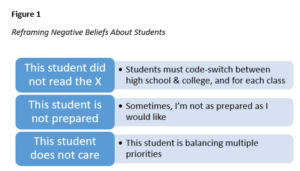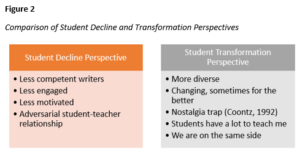While attending a student success workshop a few years ago and gaining strategies to connect with students, I thought, “What about how hard I work just to be friendly and kind?” Although the workshop was beneficial, it seemed like a foundational portion of my labor was invisible. What about the herculean, behind-the-scenes self-regulation that I employ to enjoy, not just endure, my students and to be an accessible instructor? I worried that other instructors were more naturally likeable but also hoped that I wasn’t alone in my desire and work to be a better version of myself.
At the time, I used the term emotional labor to explain the hidden labor we do at work and at home. I didn’t start thinking about strategies to optimize my emotional labor until I taught a new class on social and emotional learning (SEL) in early childhood. While teaching future preschool teachers about the importance of teacher self-reflection and emotion regulation in promoting children’s academic success (Katz, 2014), I was struck by the parallels to my own role. I decided to investigate emotional labor and translate relevant strategies for early childhood educators to postsecondary educators. What follows are seven strategies for navigating emotional labor in order to better teach college students.
Strategy 1: Acknowledge emotional labor
In 1983, Arlie Russell Hochschild conceptualized and defined emotional labor as “the management of feeling to create a publicly observable facial and bodily display” (p. 7). Research into emotional labor has focused on service occupations and less on education, with notable exceptions (see Mahoney et al., 2011). Examples of emotional labor in service roles include being pleasant as a cashier or server and staying calm as a medical professional. There is also emotional labor at home, which includes being annoyed when someone is not doing their chores but managing to ask them nicely anyway. My own emotional labor as a teacher is evident in the tension created in being kind even when I am irritable. It is essentially an internal process to create an external display and this invisible labor deserves acknowledgment (Hochschild, 1983).
One way to “see” our emotional labor is to describe it with a metaphor. I often think of my large in-person classes as Broadway matinee performances. For online teaching, I imagine myself as an anchor for students who could potentially feel adrift. Other faculty have shared metaphors such as “flipping the switch” and “putting on their teacher hat” or asked, “What would Mr. Rogers do?” Regarding emotional labor during COVID-19, some faculty have said that having fewer in-person performances decreased their emotional labor. Others have described increased labor due to managing their own, their family members’, and their students’ emotions.
Mahoney et al. (2011) studied several forms of emotional labor for teachers: suppressing negative emotion, faking positive emotion, and expressing genuine positive emotion. These authors found that of those three forms, only professors’ genuine positive emotion correlated with what we want: higher job satisfaction and commitment and lower emotional exhaustion. So, how can we cultivate genuine positive emotion so that we can enjoy our jobs more and have more energy? Here’s where we return to the strategies from early childhood education.
Pause and reflect: What percentage of your brain power in teaching goes to emotional labor? Is there a metaphor for your emotional labor in teaching?
Strategy 2: Increase self-awareness
Katz (2014) suggests that teachers gain self-awareness in areas that include self-regulation (e.g., how we respond to stress, emotional awareness), their strengths and weaknesses as a teacher, and their beliefs about their role. In gaining awareness about my own self-regulation, I now understand that when I am stressed, I tend to stiff-arm everyone and default to no. I also know that I’m sensitive to criticism and prone to shame. Regarding strengths, I’m organized, but a weakness is that I cannot learn names (hasn’t Zoom been great for that?). In terms of my beliefs about my role, I became aware that I believed that email wasn’t my real work and was just an annoying detractor, and now I’ve come to accept that emailing kindly is a key part of my job.
Pause and reflect: What is your self-awareness regarding self-regulation, your strengths and weaknesses, and your beliefs about your role?
Strategy 3: Examine beliefs about challenging behavior
Let’s see how self-awareness ties into our beliefs about challenging behavior (not challenging students). We all have “hot buttons” or things that students do that set us off (CSEFEL, 2013). For example, because my default response under stress is to stiff-arm and always be running late, one of my hot buttons is when students interrupt me before class when I’m rushing to get technology set up. I can unconsciously believe that the student is intentionally inconveniencing me, and I am more inclined to say no to their requests. Now I remind myself that it is scary for them to approach a teacher; I take a deep breath, thank them, and ask whether they can talk after class or email me.
Pause and reflect: What is a hot button for you? What is your negative belief about the student? What empathy for students can you summon? What is another way you can respond and still be authentic?
Strategy 4: Reframe beliefs about students
An extension of examining our beliefs about challenging behavior is to reframe our beliefs. If our goal is to experience genuine positive emotion, one way is to reframe negative beliefs about students (CSEFEL, 2013). When I catch myself thinking something negative about a student, I try to reframe it (see Figure 1). For example, I remind myself that every instructor has different policies and course structure, or how challenging it can be to find information on websites.

Sometimes I find myself in a faculty conversation where we are complaining about students: “Kids these days . . . they are not as good writers, not working as hard, not as prepared . . . as we were.” I think of a quote from the family historian Stephen Mintz (2014): “For more than three centuries, Americans have feared that the younger generation is going to hell in a handbasket” (p. 258). I refer to this as the student decline perspective, which I modeled after the family decline perspective identified by Stephanie Coontz in 1992. If I reframe students as transforming instead of declining (see Figure 2), then I recognize that college students are increasingly diverse, that students are changing and sometimes for the better, and that nostalgia is real (i.e., we probably were not as great as we remember). Then I realize that students have a lot to teach me and we are all on the same side.

Pause and reflect: What is one reframe you use for a student’s challenging behavior?
Strategy 5: Practice positive rehearsal
To experience genuine positive emotion for our students, we can normalize our negative reactions but avoid rehearsing negative thoughts (“I don’t want to go to class!” on repeat). When I’m reluctant to teach, I use positive rehearsal to divert my negative thoughts and remind myself that students deserve to have a teacher that enjoys them. I remember that just as we wouldn’t want a preschool teacher who doesn’t like little kids, college instructors owe it to their students to like them. Sometimes when I’m stuck in negative rehearsal (“kids these days”), I rehearse the strengths of this generation of emerging adults, such as their acceptance of diversity, openness to difficult topics, commitment to self-awareness, and respectful challenging of the status quo.
Pause and reflect: What positive statements do you rehearse?
Strategy #6: Identify guidelines for responsive relationships
Responsive relationships with students can promote genuine positive emotion (CSEFEL, 2013). To help reach this goal, we can identify guidelines for our interactions with students to fall back on when we are stressed or triggered. Here are some examples:
- Be genuine, curious, and empathic.
- Avoid defensiveness.
- Practice authoritative teaching: kindness with rules.
- Use a humanistic tone: “You are basically a good, capable person.”
We all strive to communicate with students in a way that preserves their self-esteem and promotes self-efficacy. When I’m irritated, I imagine colleagues in positions of power at my university who have interacted with me in a kind way, even if I have been frustrated or ignorant.
Pause and reflect: What guides you in creating responsive relationships with students?
Strategy 7: Cultivate a prevention mindset
This last strategy is about preventing negative emotion. The clearer our course materials and policies are, the fewer challenging behaviors our students exhibit (Kaiser & Rasminsky, 2017), and the less negative emotion we must manage. Developing empathy for how students code-shift between every class has motivated me to give students multiple pathways to navigate an online course. When students ask me where something is on Canvas, I thank them for letting me know about their confusion and ask them where they were looking so that I can put a hyperlink there. I also keep running lists of elements to clarify before teaching the class again.
Pause and reflect: What do you do to prevent challenging behaviors?
Conclusion
An implicit theme in these strategies is empathy. Paradoxically, the more we can acknowledge and validate our negative emotions and reactions, the more we can experience empathy for our students. If we can experience genuine positive emotion rather than just suppress our negative feelings or fake positivity, then we can enjoy our jobs more and for longer.
This article first appeared in Faculty Focus on September 20, 2021. © Magna Publications. All rights reserved.
Ashley Harvey, PhD, is an associate professor in human development and family studies at Colorado State University.


Note. Adapted from Coontz, S. (1992). The way we never were: American families and the nostalgia trap. Basic Books.
References
Center on the Social and Emotional Foundations for Early Learning [CSEFEL]. (2013). Promoting children’s success: Building relationships and creating supportive environments. http://csefel.vanderbilt.edu/resources/training_preschool.html#mod1
Coontz, S. (1992). The way we never were: American families and the nostalgia trap. Basic Books.
Hochschild, A. R. (1983). The managed heart: Commercialization of human feeling. University of California Press.
Kaiser, B., & Rasminsky, J. S. (2017). Challenging behavior in young children (4th ed.). Pearson.
Katz, J. E. (2014). Guiding children’s social and emotional development: A reflective approach. Pearson.
Mahoney, K. T., Buboltz, W. C., Jr., Buckner V, J. E., & Doverspike, D. (2011).Emotional labor in American professors. Journal of Occupational Health Psychology, 16(4), 406–423. https://doi.org/10.1037/a0025099
Mintz, S. (2014). Beyond sentimentality: American Childhood as a social and cultural construct. In A. Skolnick & J. Skolnick (Eds.), Family in transition (17th ed., pp. 249-262). Pearson.



